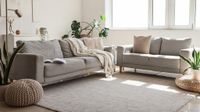In the ever-evolving world of home design, certain features can significantly date a living space, and one such element is the infamous couch with cup holders. While these sofas may have been a staple in many homes, they are now seen as relics of a bygone era. Interior designer Rebecca Hay recently highlighted this trend in an interview shared on YouTube, stating, "Think about functionality. Again, sure, it functions. You can put your glass or your beer in it. But, who's gonna clean it? How can you clean it? Is it removable?" This critique underscores the growing preference for sleek, modern aesthetics that prioritize ease of maintenance alongside style.
As homeowners increasingly seek to modernize their spaces, the push to move away from outdated designs is gaining momentum. A sofa with cup holders not only detracts from the overall appeal of a room but also presents practical challenges when it comes to cleaning. Many homeowners may find that the functionality of these cup holders does not outweigh the hassle they create. Instead, opting for a couch with hidden cup holders or even forgoing the feature altogether can keep a living room looking fresh and contemporary.
For those looking to update their furniture, options abound. The Reclining Sleeper Sofa with Cup Holder available from Wayfair features hidden cup holders, allowing for a cleaner look without sacrificing functionality. Alternatively, the Broderik Sofa with Solid Wood Cup Holder from Wayfair offers a chic wooden option that can enhance the decor of a boho-style living room. Homeowners can also consider using accessories like the ROCDEER Sofa Arm Tray, which provides a stylish solution for drink storage without permanently altering the couch itself.
Beyond individual pieces of furniture, broader trends in home design reflect changing lifestyles and preferences. Over the past two decades, open-plan layouts have dominated the housing market, but recent shifts indicate a growing desire for more defined spaces within homes. Families are now looking for homes that not only feature open-plan kitchens, dining, and living areas but also include separate rooms for relaxation, work, and entertainment.
According to the McGrath Report 2025, Adam Haddow, director of SJB architecture and design, noted that the desire for serenity at home is driving this shift. He stated, "Serenity is also working out how to live closer together, better. This is resulting in the death of the ‘open plan’, towards more defined rooms and spaces, so that you can find space to be quietly alone.” This change reflects a growing need for personal space, especially as more families embrace remote work and require dedicated areas for productivity.
Moreover, the trend of multi-generational living is on the rise, largely due to economic factors such as high living costs and interest rates. Young adults are remaining in their family homes longer, allowing them to save for their own properties or invest in rental opportunities. Concurrently, young families are increasingly cohabiting with their parents, not only for financial assistance but also for caregiving support. This shift necessitates homes that can adapt to the needs of multiple generations.
As families seek larger homes with flexible layouts, features such as granny flats have gained popularity. These separate living quarters provide privacy for extended families while still allowing for shared experiences. The demand for homes with two stories or distinct wings is a direct response to the evolving dynamics of family life.
Despite the trend towards more defined living spaces, the open-plan kitchen remains a beloved feature in Australian homes. The kitchen has transformed into the heart of the home, facilitating easy entertaining and family gatherings. Shows like My Kitchen Rules and MasterChef have fueled this passion for home cooking, making the kitchen a focal point for both style and functionality.
As Australians continue to prioritize entertaining at home, the kitchen's design has become crucial to the overall aesthetic of a property. Homeowners are now investing significantly in contemporary kitchen renovations, understanding that a well-designed kitchen can greatly enhance a home's value. The kitchen not only sets the tone for the entire house but also provides the greatest wow factor for potential buyers.
In summary, whether it’s updating the living room with modern furniture or rethinking the layout of a home to accommodate changing family dynamics, the trends in home design reflect a desire for functionality, comfort, and style. As homeowners navigate these changes, they are finding new ways to create spaces that resonate with their lifestyles while keeping their homes looking fresh and inviting.




